Management Style and Organizational Structure at British American Tobacco
VerifiedAdded on 2023/01/06
|14
|4196
|1
AI Summary
This report analyzes the management style of Mr. Jack Bowles as the CEO of British American Tobacco and evaluates the steps taken in the context of organizational structure for high performance. It also examines the impact of organizational culture on employees and discusses the types of motivation used at British American Tobacco.
Contribute Materials
Your contribution can guide someone’s learning journey. Share your
documents today.
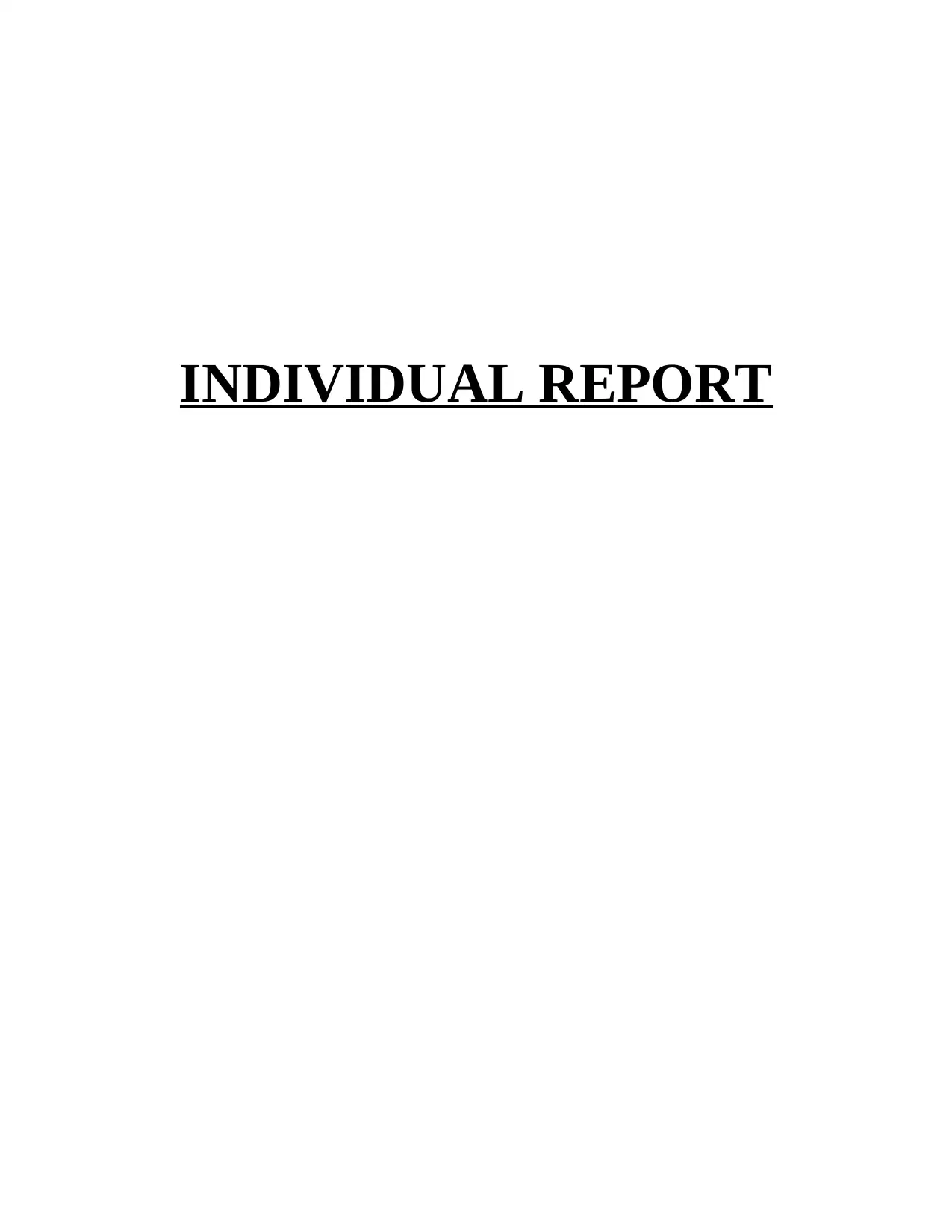
INDIVIDUAL REPORT
Secure Best Marks with AI Grader
Need help grading? Try our AI Grader for instant feedback on your assignments.
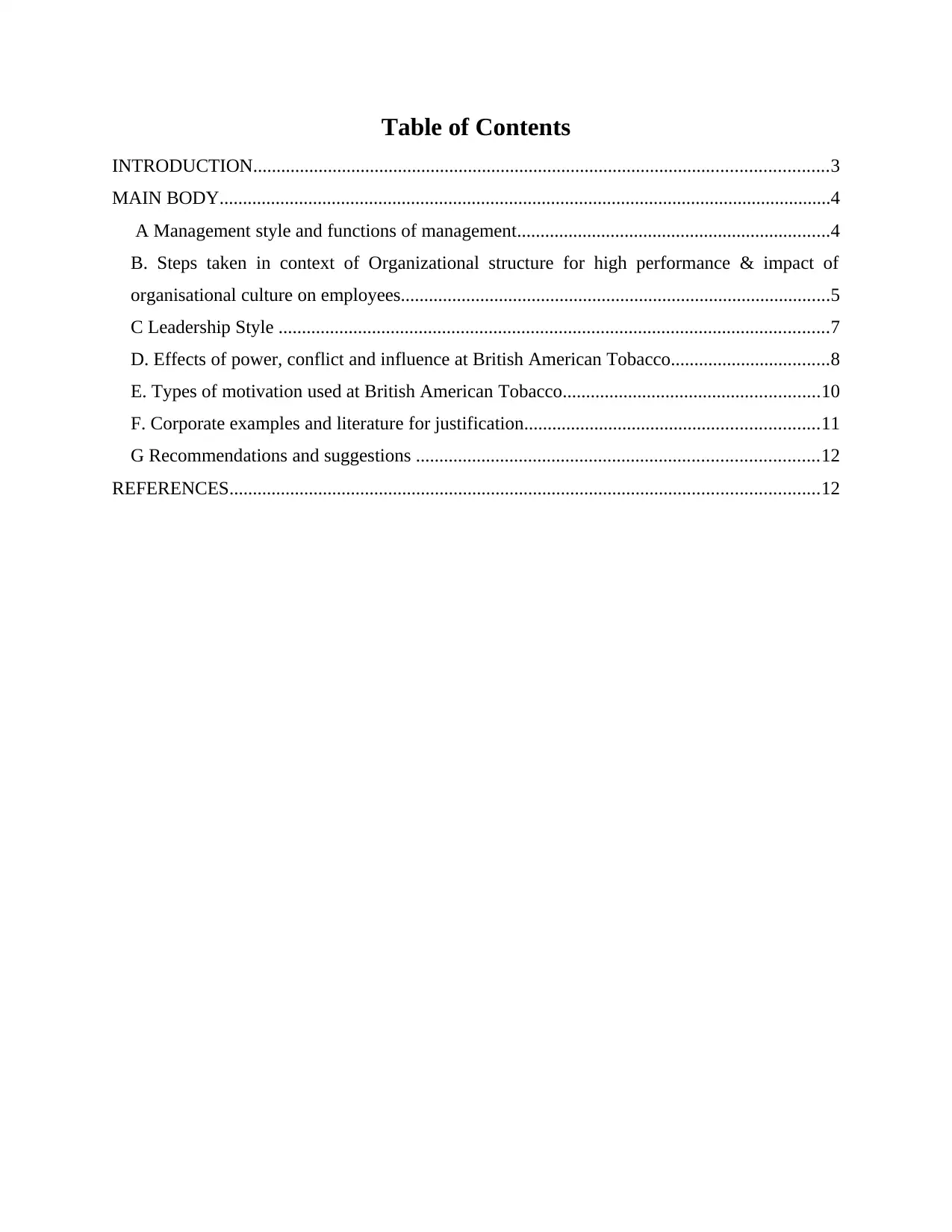
Table of Contents
INTRODUCTION...........................................................................................................................3
MAIN BODY...................................................................................................................................4
A Management style and functions of management...................................................................4
B. Steps taken in context of Organizational structure for high performance & impact of
organisational culture on employees............................................................................................5
C Leadership Style ......................................................................................................................7
D. Effects of power, conflict and influence at British American Tobacco..................................8
E. Types of motivation used at British American Tobacco.......................................................10
F. Corporate examples and literature for justification...............................................................11
G Recommendations and suggestions ......................................................................................12
REFERENCES..............................................................................................................................12
INTRODUCTION...........................................................................................................................3
MAIN BODY...................................................................................................................................4
A Management style and functions of management...................................................................4
B. Steps taken in context of Organizational structure for high performance & impact of
organisational culture on employees............................................................................................5
C Leadership Style ......................................................................................................................7
D. Effects of power, conflict and influence at British American Tobacco..................................8
E. Types of motivation used at British American Tobacco.......................................................10
F. Corporate examples and literature for justification...............................................................11
G Recommendations and suggestions ......................................................................................12
REFERENCES..............................................................................................................................12
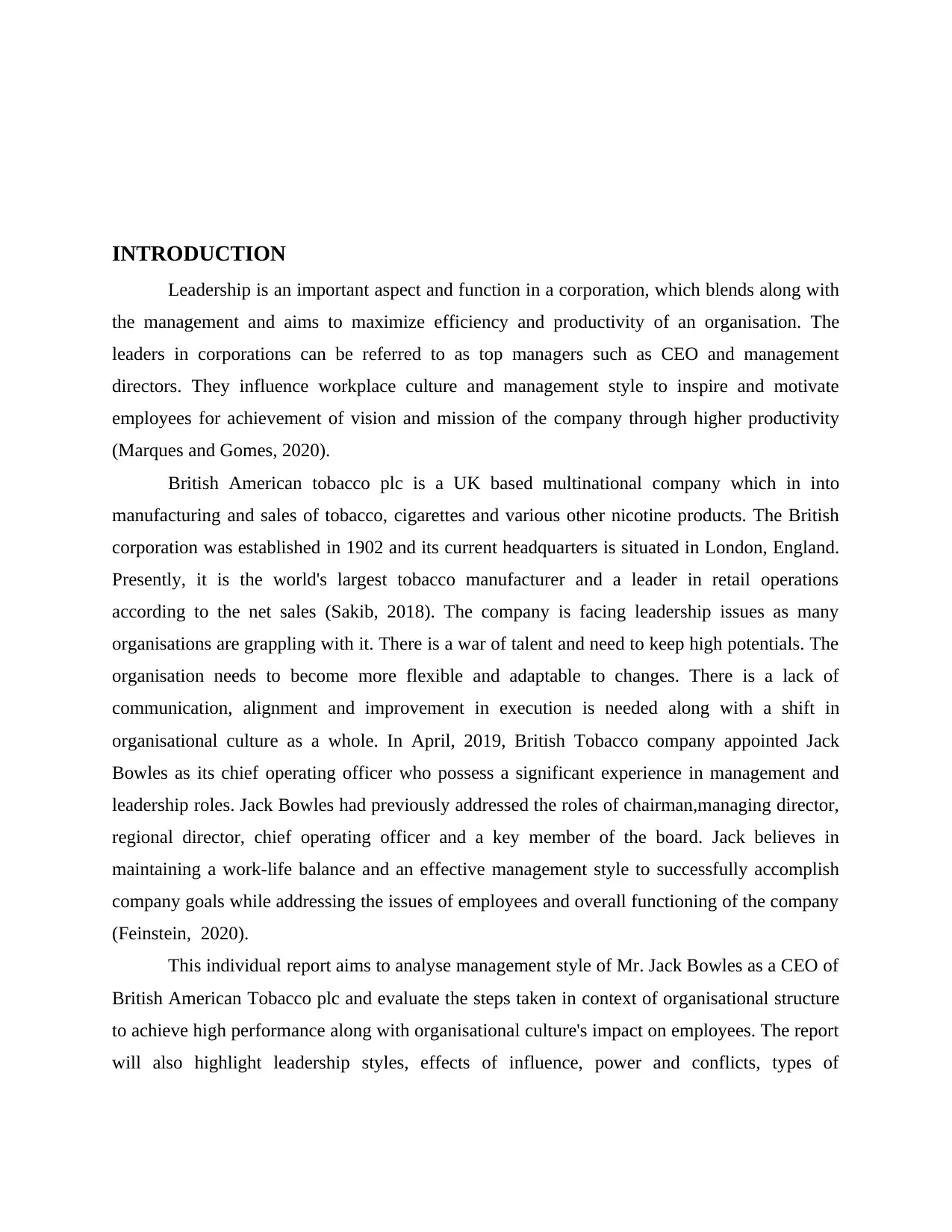
INTRODUCTION
Leadership is an important aspect and function in a corporation, which blends along with
the management and aims to maximize efficiency and productivity of an organisation. The
leaders in corporations can be referred to as top managers such as CEO and management
directors. They influence workplace culture and management style to inspire and motivate
employees for achievement of vision and mission of the company through higher productivity
(Marques and Gomes, 2020).
British American tobacco plc is a UK based multinational company which in into
manufacturing and sales of tobacco, cigarettes and various other nicotine products. The British
corporation was established in 1902 and its current headquarters is situated in London, England.
Presently, it is the world's largest tobacco manufacturer and a leader in retail operations
according to the net sales (Sakib, 2018). The company is facing leadership issues as many
organisations are grappling with it. There is a war of talent and need to keep high potentials. The
organisation needs to become more flexible and adaptable to changes. There is a lack of
communication, alignment and improvement in execution is needed along with a shift in
organisational culture as a whole. In April, 2019, British Tobacco company appointed Jack
Bowles as its chief operating officer who possess a significant experience in management and
leadership roles. Jack Bowles had previously addressed the roles of chairman,managing director,
regional director, chief operating officer and a key member of the board. Jack believes in
maintaining a work-life balance and an effective management style to successfully accomplish
company goals while addressing the issues of employees and overall functioning of the company
(Feinstein, 2020).
This individual report aims to analyse management style of Mr. Jack Bowles as a CEO of
British American Tobacco plc and evaluate the steps taken in context of organisational structure
to achieve high performance along with organisational culture's impact on employees. The report
will also highlight leadership styles, effects of influence, power and conflicts, types of
Leadership is an important aspect and function in a corporation, which blends along with
the management and aims to maximize efficiency and productivity of an organisation. The
leaders in corporations can be referred to as top managers such as CEO and management
directors. They influence workplace culture and management style to inspire and motivate
employees for achievement of vision and mission of the company through higher productivity
(Marques and Gomes, 2020).
British American tobacco plc is a UK based multinational company which in into
manufacturing and sales of tobacco, cigarettes and various other nicotine products. The British
corporation was established in 1902 and its current headquarters is situated in London, England.
Presently, it is the world's largest tobacco manufacturer and a leader in retail operations
according to the net sales (Sakib, 2018). The company is facing leadership issues as many
organisations are grappling with it. There is a war of talent and need to keep high potentials. The
organisation needs to become more flexible and adaptable to changes. There is a lack of
communication, alignment and improvement in execution is needed along with a shift in
organisational culture as a whole. In April, 2019, British Tobacco company appointed Jack
Bowles as its chief operating officer who possess a significant experience in management and
leadership roles. Jack Bowles had previously addressed the roles of chairman,managing director,
regional director, chief operating officer and a key member of the board. Jack believes in
maintaining a work-life balance and an effective management style to successfully accomplish
company goals while addressing the issues of employees and overall functioning of the company
(Feinstein, 2020).
This individual report aims to analyse management style of Mr. Jack Bowles as a CEO of
British American Tobacco plc and evaluate the steps taken in context of organisational structure
to achieve high performance along with organisational culture's impact on employees. The report
will also highlight leadership styles, effects of influence, power and conflicts, types of
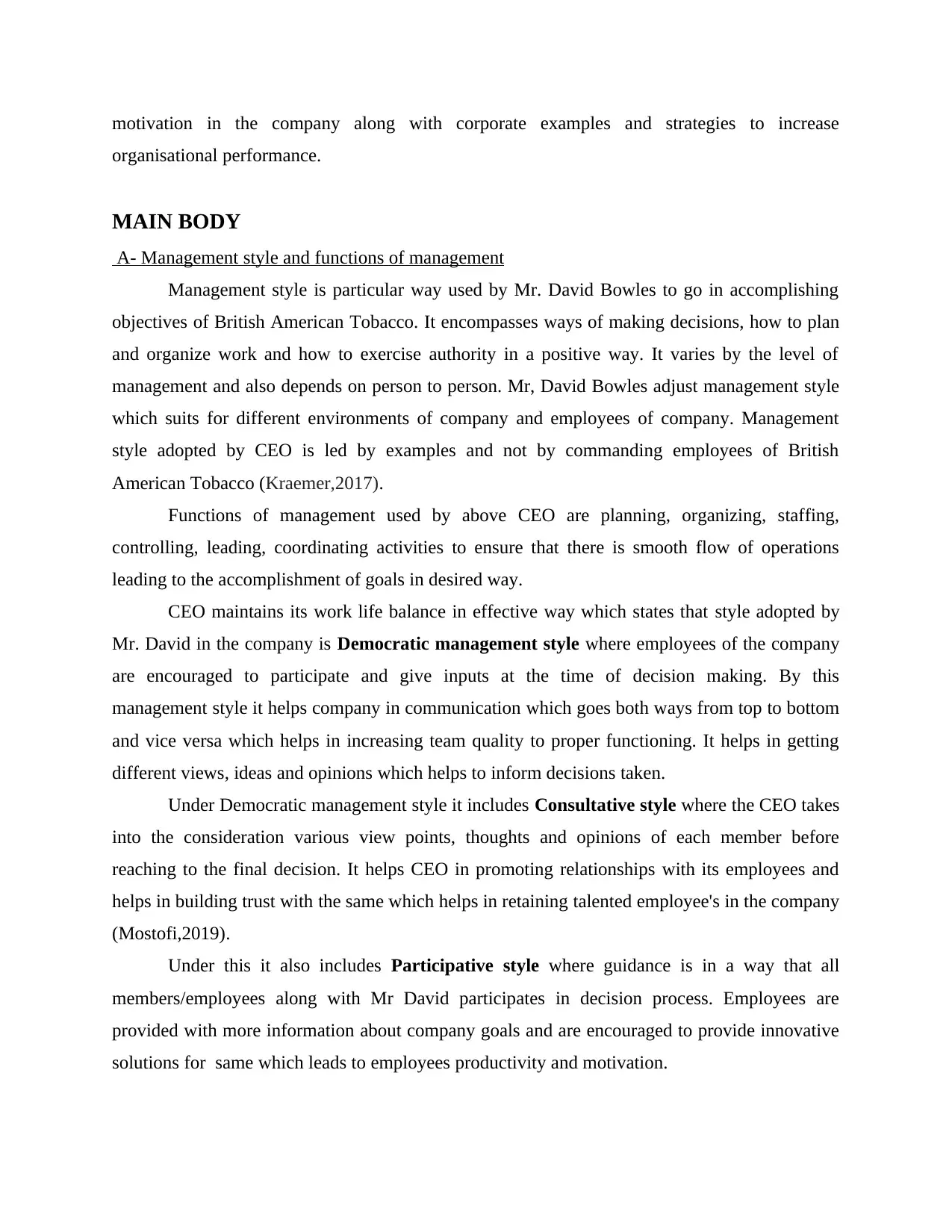
motivation in the company along with corporate examples and strategies to increase
organisational performance.
MAIN BODY
A- Management style and functions of management
Management style is particular way used by Mr. David Bowles to go in accomplishing
objectives of British American Tobacco. It encompasses ways of making decisions, how to plan
and organize work and how to exercise authority in a positive way. It varies by the level of
management and also depends on person to person. Mr, David Bowles adjust management style
which suits for different environments of company and employees of company. Management
style adopted by CEO is led by examples and not by commanding employees of British
American Tobacco (Kraemer,2017).
Functions of management used by above CEO are planning, organizing, staffing,
controlling, leading, coordinating activities to ensure that there is smooth flow of operations
leading to the accomplishment of goals in desired way.
CEO maintains its work life balance in effective way which states that style adopted by
Mr. David in the company is Democratic management style where employees of the company
are encouraged to participate and give inputs at the time of decision making. By this
management style it helps company in communication which goes both ways from top to bottom
and vice versa which helps in increasing team quality to proper functioning. It helps in getting
different views, ideas and opinions which helps to inform decisions taken.
Under Democratic management style it includes Consultative style where the CEO takes
into the consideration various view points, thoughts and opinions of each member before
reaching to the final decision. It helps CEO in promoting relationships with its employees and
helps in building trust with the same which helps in retaining talented employee's in the company
(Mostofi,2019).
Under this it also includes Participative style where guidance is in a way that all
members/employees along with Mr David participates in decision process. Employees are
provided with more information about company goals and are encouraged to provide innovative
solutions for same which leads to employees productivity and motivation.
organisational performance.
MAIN BODY
A- Management style and functions of management
Management style is particular way used by Mr. David Bowles to go in accomplishing
objectives of British American Tobacco. It encompasses ways of making decisions, how to plan
and organize work and how to exercise authority in a positive way. It varies by the level of
management and also depends on person to person. Mr, David Bowles adjust management style
which suits for different environments of company and employees of company. Management
style adopted by CEO is led by examples and not by commanding employees of British
American Tobacco (Kraemer,2017).
Functions of management used by above CEO are planning, organizing, staffing,
controlling, leading, coordinating activities to ensure that there is smooth flow of operations
leading to the accomplishment of goals in desired way.
CEO maintains its work life balance in effective way which states that style adopted by
Mr. David in the company is Democratic management style where employees of the company
are encouraged to participate and give inputs at the time of decision making. By this
management style it helps company in communication which goes both ways from top to bottom
and vice versa which helps in increasing team quality to proper functioning. It helps in getting
different views, ideas and opinions which helps to inform decisions taken.
Under Democratic management style it includes Consultative style where the CEO takes
into the consideration various view points, thoughts and opinions of each member before
reaching to the final decision. It helps CEO in promoting relationships with its employees and
helps in building trust with the same which helps in retaining talented employee's in the company
(Mostofi,2019).
Under this it also includes Participative style where guidance is in a way that all
members/employees along with Mr David participates in decision process. Employees are
provided with more information about company goals and are encouraged to provide innovative
solutions for same which leads to employees productivity and motivation.
Secure Best Marks with AI Grader
Need help grading? Try our AI Grader for instant feedback on your assignments.
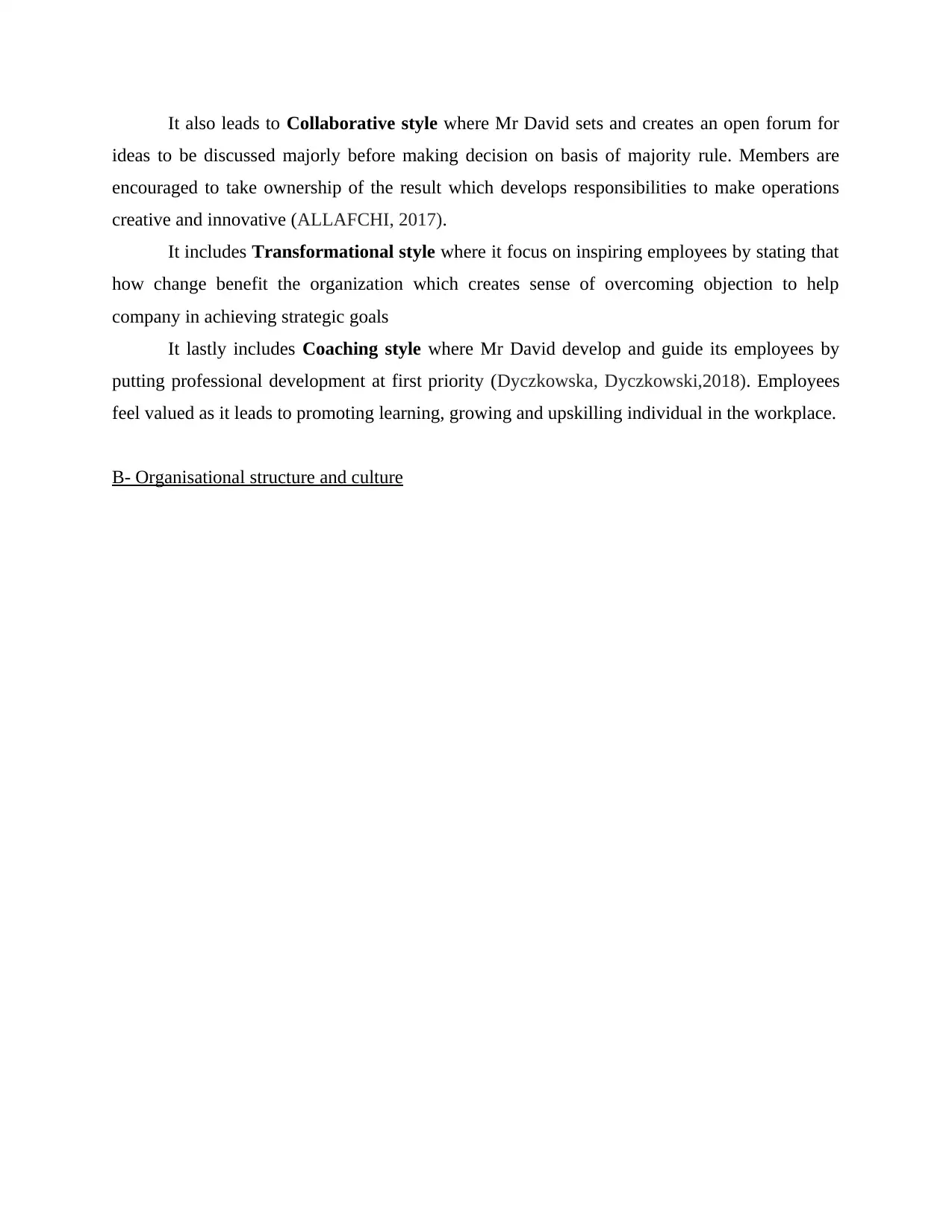
It also leads to Collaborative style where Mr David sets and creates an open forum for
ideas to be discussed majorly before making decision on basis of majority rule. Members are
encouraged to take ownership of the result which develops responsibilities to make operations
creative and innovative (ALLAFCHI, 2017).
It includes Transformational style where it focus on inspiring employees by stating that
how change benefit the organization which creates sense of overcoming objection to help
company in achieving strategic goals
It lastly includes Coaching style where Mr David develop and guide its employees by
putting professional development at first priority (Dyczkowska, Dyczkowski,2018). Employees
feel valued as it leads to promoting learning, growing and upskilling individual in the workplace.
B- Organisational structure and culture
ideas to be discussed majorly before making decision on basis of majority rule. Members are
encouraged to take ownership of the result which develops responsibilities to make operations
creative and innovative (ALLAFCHI, 2017).
It includes Transformational style where it focus on inspiring employees by stating that
how change benefit the organization which creates sense of overcoming objection to help
company in achieving strategic goals
It lastly includes Coaching style where Mr David develop and guide its employees by
putting professional development at first priority (Dyczkowska, Dyczkowski,2018). Employees
feel valued as it leads to promoting learning, growing and upskilling individual in the workplace.
B- Organisational structure and culture
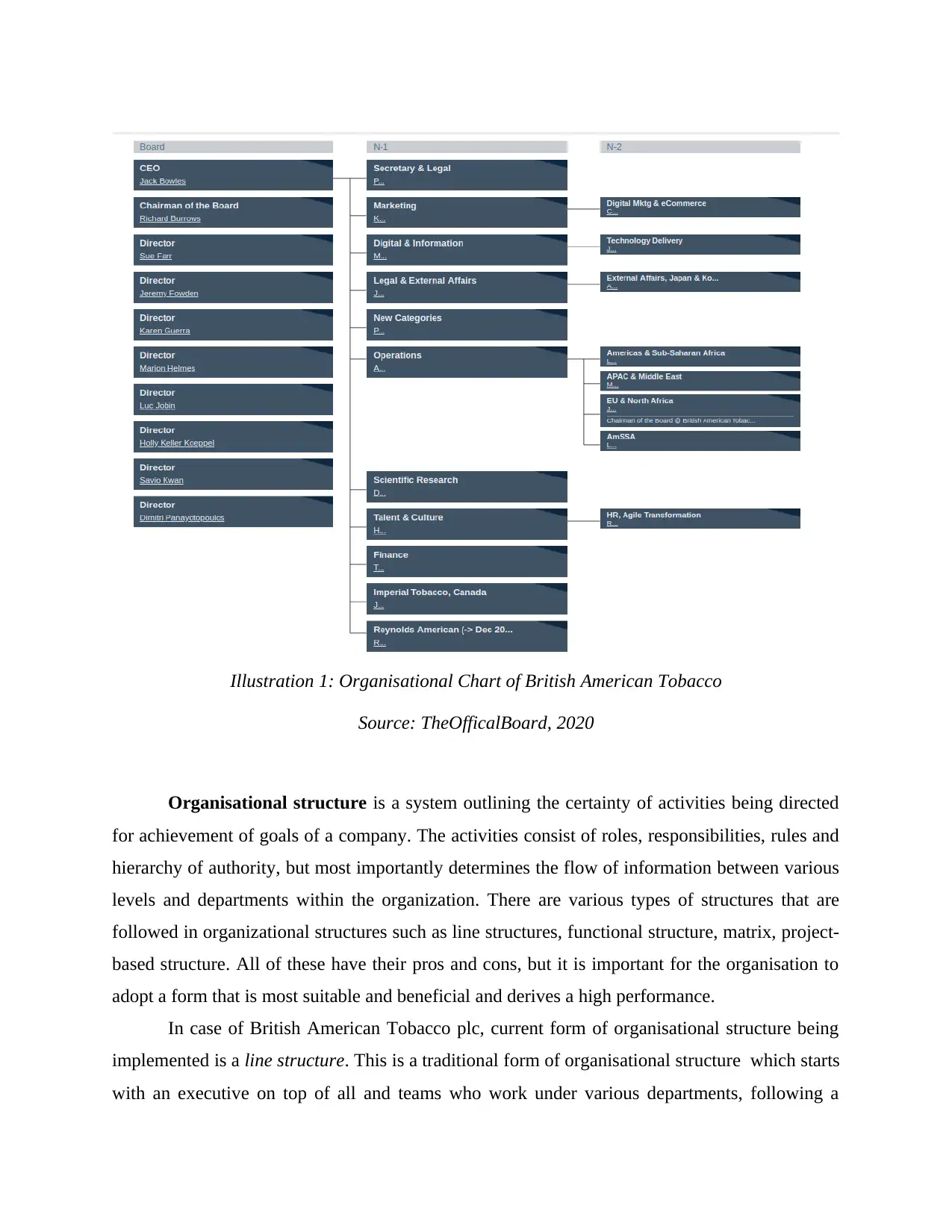
Organisational structure is a system outlining the certainty of activities being directed
for achievement of goals of a company. The activities consist of roles, responsibilities, rules and
hierarchy of authority, but most importantly determines the flow of information between various
levels and departments within the organization. There are various types of structures that are
followed in organizational structures such as line structures, functional structure, matrix, project-
based structure. All of these have their pros and cons, but it is important for the organisation to
adopt a form that is most suitable and beneficial and derives a high performance.
In case of British American Tobacco plc, current form of organisational structure being
implemented is a line structure. This is a traditional form of organisational structure which starts
with an executive on top of all and teams who work under various departments, following a
Illustration 1: Organisational Chart of British American Tobacco
Source: TheOfficalBoard, 2020
for achievement of goals of a company. The activities consist of roles, responsibilities, rules and
hierarchy of authority, but most importantly determines the flow of information between various
levels and departments within the organization. There are various types of structures that are
followed in organizational structures such as line structures, functional structure, matrix, project-
based structure. All of these have their pros and cons, but it is important for the organisation to
adopt a form that is most suitable and beneficial and derives a high performance.
In case of British American Tobacco plc, current form of organisational structure being
implemented is a line structure. This is a traditional form of organisational structure which starts
with an executive on top of all and teams who work under various departments, following a
Illustration 1: Organisational Chart of British American Tobacco
Source: TheOfficalBoard, 2020
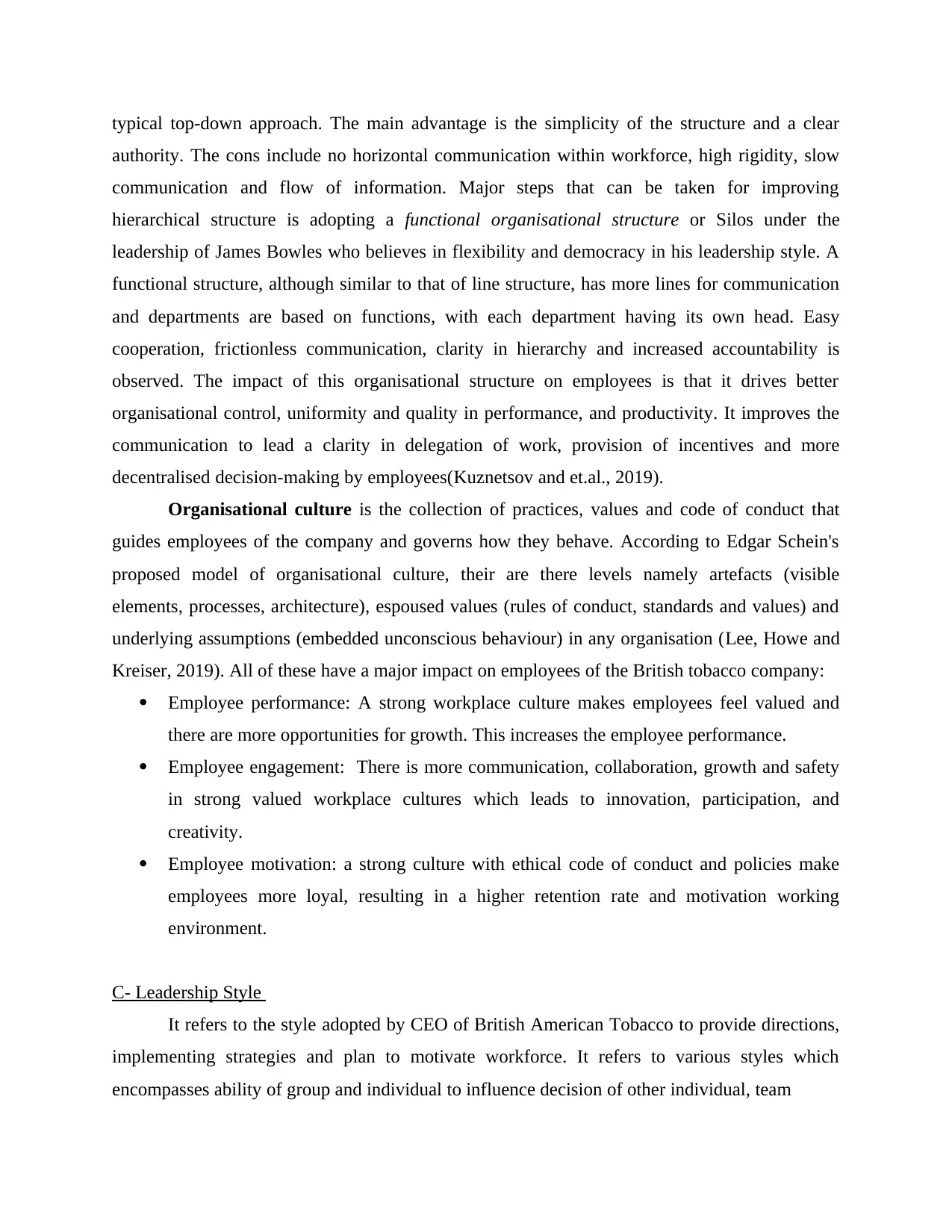
typical top-down approach. The main advantage is the simplicity of the structure and a clear
authority. The cons include no horizontal communication within workforce, high rigidity, slow
communication and flow of information. Major steps that can be taken for improving
hierarchical structure is adopting a functional organisational structure or Silos under the
leadership of James Bowles who believes in flexibility and democracy in his leadership style. A
functional structure, although similar to that of line structure, has more lines for communication
and departments are based on functions, with each department having its own head. Easy
cooperation, frictionless communication, clarity in hierarchy and increased accountability is
observed. The impact of this organisational structure on employees is that it drives better
organisational control, uniformity and quality in performance, and productivity. It improves the
communication to lead a clarity in delegation of work, provision of incentives and more
decentralised decision-making by employees(Kuznetsov and et.al., 2019).
Organisational culture is the collection of practices, values and code of conduct that
guides employees of the company and governs how they behave. According to Edgar Schein's
proposed model of organisational culture, their are there levels namely artefacts (visible
elements, processes, architecture), espoused values (rules of conduct, standards and values) and
underlying assumptions (embedded unconscious behaviour) in any organisation (Lee, Howe and
Kreiser, 2019). All of these have a major impact on employees of the British tobacco company:
Employee performance: A strong workplace culture makes employees feel valued and
there are more opportunities for growth. This increases the employee performance.
Employee engagement: There is more communication, collaboration, growth and safety
in strong valued workplace cultures which leads to innovation, participation, and
creativity.
Employee motivation: a strong culture with ethical code of conduct and policies make
employees more loyal, resulting in a higher retention rate and motivation working
environment.
C- Leadership Style
It refers to the style adopted by CEO of British American Tobacco to provide directions,
implementing strategies and plan to motivate workforce. It refers to various styles which
encompasses ability of group and individual to influence decision of other individual, team
authority. The cons include no horizontal communication within workforce, high rigidity, slow
communication and flow of information. Major steps that can be taken for improving
hierarchical structure is adopting a functional organisational structure or Silos under the
leadership of James Bowles who believes in flexibility and democracy in his leadership style. A
functional structure, although similar to that of line structure, has more lines for communication
and departments are based on functions, with each department having its own head. Easy
cooperation, frictionless communication, clarity in hierarchy and increased accountability is
observed. The impact of this organisational structure on employees is that it drives better
organisational control, uniformity and quality in performance, and productivity. It improves the
communication to lead a clarity in delegation of work, provision of incentives and more
decentralised decision-making by employees(Kuznetsov and et.al., 2019).
Organisational culture is the collection of practices, values and code of conduct that
guides employees of the company and governs how they behave. According to Edgar Schein's
proposed model of organisational culture, their are there levels namely artefacts (visible
elements, processes, architecture), espoused values (rules of conduct, standards and values) and
underlying assumptions (embedded unconscious behaviour) in any organisation (Lee, Howe and
Kreiser, 2019). All of these have a major impact on employees of the British tobacco company:
Employee performance: A strong workplace culture makes employees feel valued and
there are more opportunities for growth. This increases the employee performance.
Employee engagement: There is more communication, collaboration, growth and safety
in strong valued workplace cultures which leads to innovation, participation, and
creativity.
Employee motivation: a strong culture with ethical code of conduct and policies make
employees more loyal, resulting in a higher retention rate and motivation working
environment.
C- Leadership Style
It refers to the style adopted by CEO of British American Tobacco to provide directions,
implementing strategies and plan to motivate workforce. It refers to various styles which
encompasses ability of group and individual to influence decision of other individual, team
Paraphrase This Document
Need a fresh take? Get an instant paraphrase of this document with our AI Paraphraser
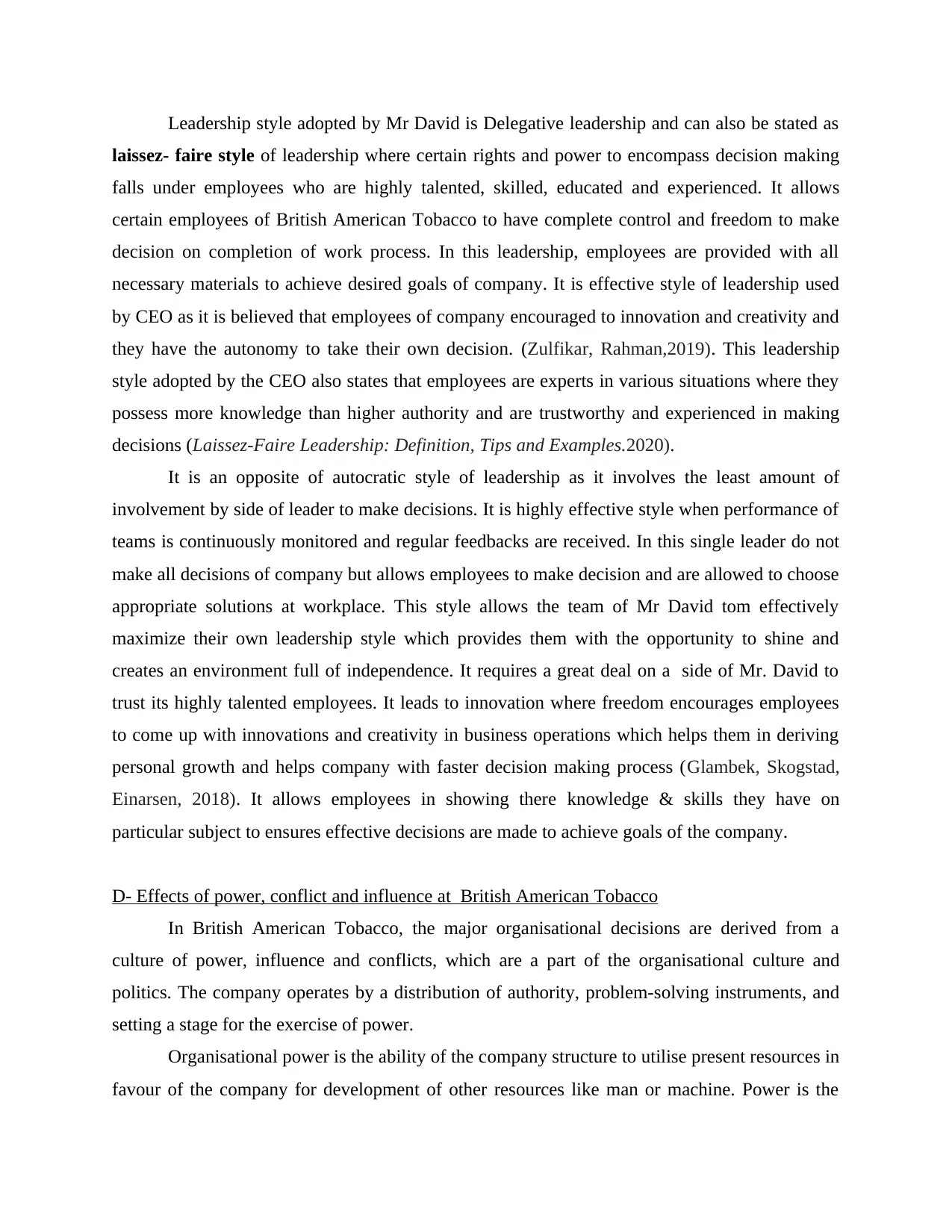
Leadership style adopted by Mr David is Delegative leadership and can also be stated as
laissez- faire style of leadership where certain rights and power to encompass decision making
falls under employees who are highly talented, skilled, educated and experienced. It allows
certain employees of British American Tobacco to have complete control and freedom to make
decision on completion of work process. In this leadership, employees are provided with all
necessary materials to achieve desired goals of company. It is effective style of leadership used
by CEO as it is believed that employees of company encouraged to innovation and creativity and
they have the autonomy to take their own decision. (Zulfikar, Rahman,2019). This leadership
style adopted by the CEO also states that employees are experts in various situations where they
possess more knowledge than higher authority and are trustworthy and experienced in making
decisions (Laissez-Faire Leadership: Definition, Tips and Examples.2020).
It is an opposite of autocratic style of leadership as it involves the least amount of
involvement by side of leader to make decisions. It is highly effective style when performance of
teams is continuously monitored and regular feedbacks are received. In this single leader do not
make all decisions of company but allows employees to make decision and are allowed to choose
appropriate solutions at workplace. This style allows the team of Mr David tom effectively
maximize their own leadership style which provides them with the opportunity to shine and
creates an environment full of independence. It requires a great deal on a side of Mr. David to
trust its highly talented employees. It leads to innovation where freedom encourages employees
to come up with innovations and creativity in business operations which helps them in deriving
personal growth and helps company with faster decision making process (Glambek, Skogstad,
Einarsen, 2018). It allows employees in showing there knowledge & skills they have on
particular subject to ensures effective decisions are made to achieve goals of the company.
D- Effects of power, conflict and influence at British American Tobacco
In British American Tobacco, the major organisational decisions are derived from a
culture of power, influence and conflicts, which are a part of the organisational culture and
politics. The company operates by a distribution of authority, problem-solving instruments, and
setting a stage for the exercise of power.
Organisational power is the ability of the company structure to utilise present resources in
favour of the company for development of other resources like man or machine. Power is the
laissez- faire style of leadership where certain rights and power to encompass decision making
falls under employees who are highly talented, skilled, educated and experienced. It allows
certain employees of British American Tobacco to have complete control and freedom to make
decision on completion of work process. In this leadership, employees are provided with all
necessary materials to achieve desired goals of company. It is effective style of leadership used
by CEO as it is believed that employees of company encouraged to innovation and creativity and
they have the autonomy to take their own decision. (Zulfikar, Rahman,2019). This leadership
style adopted by the CEO also states that employees are experts in various situations where they
possess more knowledge than higher authority and are trustworthy and experienced in making
decisions (Laissez-Faire Leadership: Definition, Tips and Examples.2020).
It is an opposite of autocratic style of leadership as it involves the least amount of
involvement by side of leader to make decisions. It is highly effective style when performance of
teams is continuously monitored and regular feedbacks are received. In this single leader do not
make all decisions of company but allows employees to make decision and are allowed to choose
appropriate solutions at workplace. This style allows the team of Mr David tom effectively
maximize their own leadership style which provides them with the opportunity to shine and
creates an environment full of independence. It requires a great deal on a side of Mr. David to
trust its highly talented employees. It leads to innovation where freedom encourages employees
to come up with innovations and creativity in business operations which helps them in deriving
personal growth and helps company with faster decision making process (Glambek, Skogstad,
Einarsen, 2018). It allows employees in showing there knowledge & skills they have on
particular subject to ensures effective decisions are made to achieve goals of the company.
D- Effects of power, conflict and influence at British American Tobacco
In British American Tobacco, the major organisational decisions are derived from a
culture of power, influence and conflicts, which are a part of the organisational culture and
politics. The company operates by a distribution of authority, problem-solving instruments, and
setting a stage for the exercise of power.
Organisational power is the ability of the company structure to utilise present resources in
favour of the company for development of other resources like man or machine. Power is the
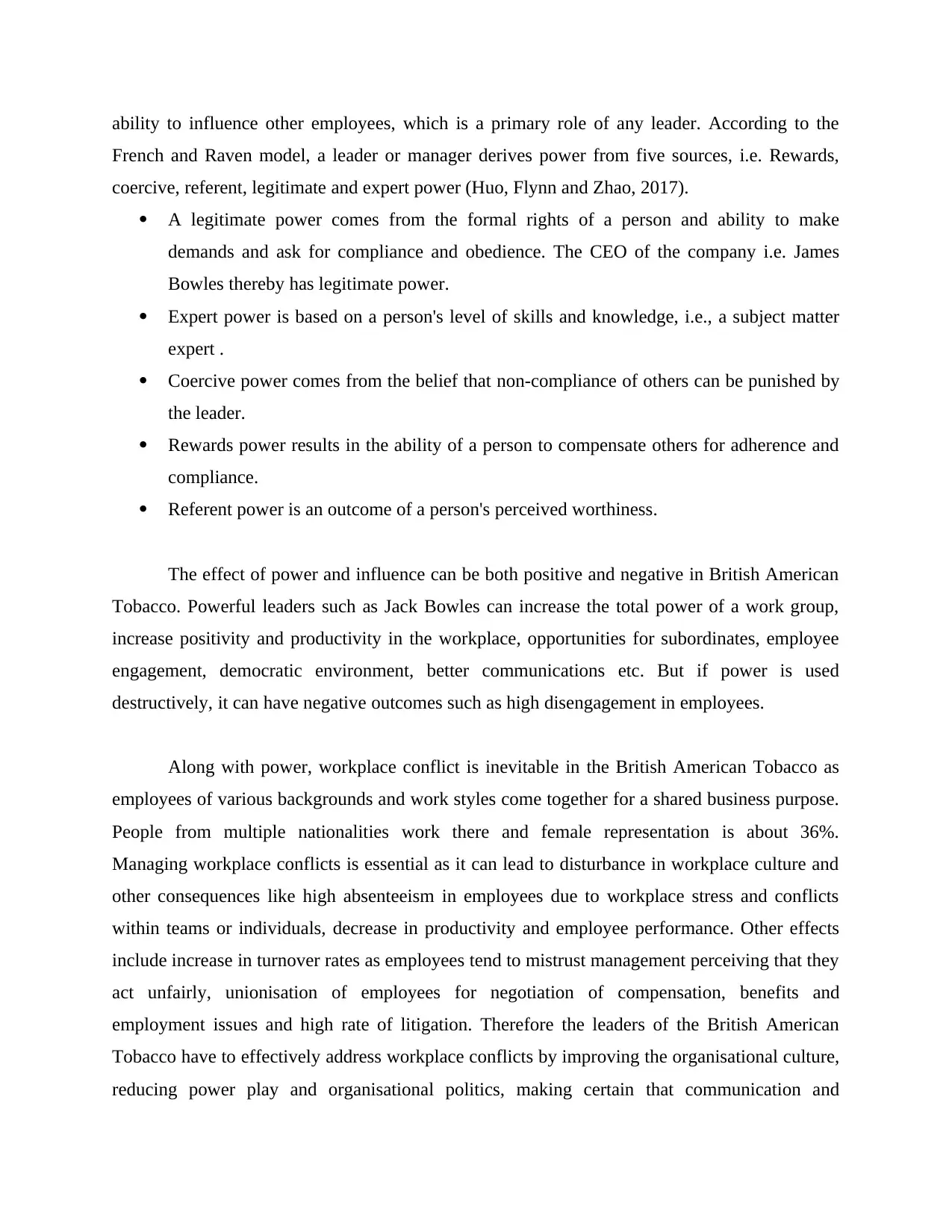
ability to influence other employees, which is a primary role of any leader. According to the
French and Raven model, a leader or manager derives power from five sources, i.e. Rewards,
coercive, referent, legitimate and expert power (Huo, Flynn and Zhao, 2017).
A legitimate power comes from the formal rights of a person and ability to make
demands and ask for compliance and obedience. The CEO of the company i.e. James
Bowles thereby has legitimate power.
Expert power is based on a person's level of skills and knowledge, i.e., a subject matter
expert .
Coercive power comes from the belief that non-compliance of others can be punished by
the leader.
Rewards power results in the ability of a person to compensate others for adherence and
compliance.
Referent power is an outcome of a person's perceived worthiness.
The effect of power and influence can be both positive and negative in British American
Tobacco. Powerful leaders such as Jack Bowles can increase the total power of a work group,
increase positivity and productivity in the workplace, opportunities for subordinates, employee
engagement, democratic environment, better communications etc. But if power is used
destructively, it can have negative outcomes such as high disengagement in employees.
Along with power, workplace conflict is inevitable in the British American Tobacco as
employees of various backgrounds and work styles come together for a shared business purpose.
People from multiple nationalities work there and female representation is about 36%.
Managing workplace conflicts is essential as it can lead to disturbance in workplace culture and
other consequences like high absenteeism in employees due to workplace stress and conflicts
within teams or individuals, decrease in productivity and employee performance. Other effects
include increase in turnover rates as employees tend to mistrust management perceiving that they
act unfairly, unionisation of employees for negotiation of compensation, benefits and
employment issues and high rate of litigation. Therefore the leaders of the British American
Tobacco have to effectively address workplace conflicts by improving the organisational culture,
reducing power play and organisational politics, making certain that communication and
French and Raven model, a leader or manager derives power from five sources, i.e. Rewards,
coercive, referent, legitimate and expert power (Huo, Flynn and Zhao, 2017).
A legitimate power comes from the formal rights of a person and ability to make
demands and ask for compliance and obedience. The CEO of the company i.e. James
Bowles thereby has legitimate power.
Expert power is based on a person's level of skills and knowledge, i.e., a subject matter
expert .
Coercive power comes from the belief that non-compliance of others can be punished by
the leader.
Rewards power results in the ability of a person to compensate others for adherence and
compliance.
Referent power is an outcome of a person's perceived worthiness.
The effect of power and influence can be both positive and negative in British American
Tobacco. Powerful leaders such as Jack Bowles can increase the total power of a work group,
increase positivity and productivity in the workplace, opportunities for subordinates, employee
engagement, democratic environment, better communications etc. But if power is used
destructively, it can have negative outcomes such as high disengagement in employees.
Along with power, workplace conflict is inevitable in the British American Tobacco as
employees of various backgrounds and work styles come together for a shared business purpose.
People from multiple nationalities work there and female representation is about 36%.
Managing workplace conflicts is essential as it can lead to disturbance in workplace culture and
other consequences like high absenteeism in employees due to workplace stress and conflicts
within teams or individuals, decrease in productivity and employee performance. Other effects
include increase in turnover rates as employees tend to mistrust management perceiving that they
act unfairly, unionisation of employees for negotiation of compensation, benefits and
employment issues and high rate of litigation. Therefore the leaders of the British American
Tobacco have to effectively address workplace conflicts by improving the organisational culture,
reducing power play and organisational politics, making certain that communication and
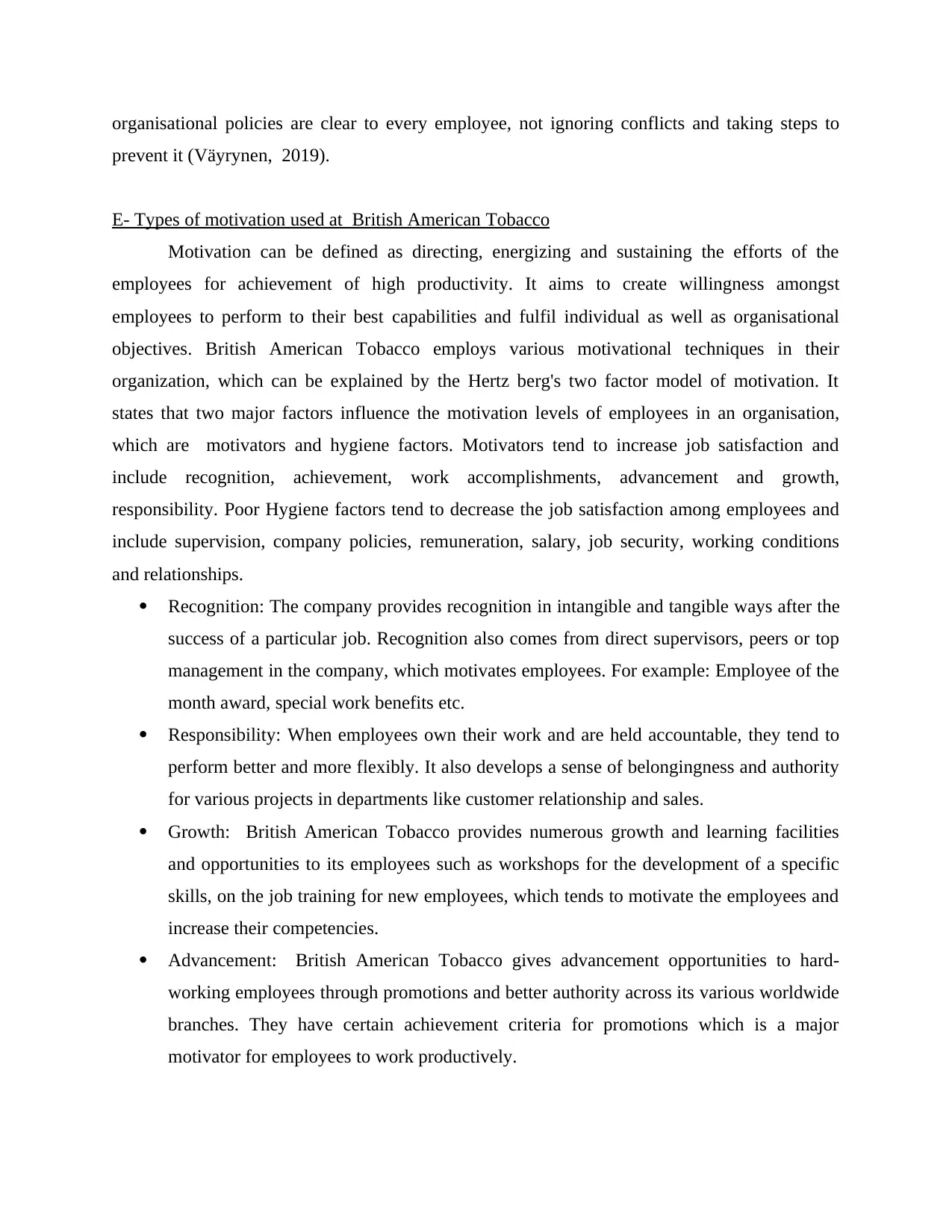
organisational policies are clear to every employee, not ignoring conflicts and taking steps to
prevent it (Väyrynen, 2019).
E- Types of motivation used at British American Tobacco
Motivation can be defined as directing, energizing and sustaining the efforts of the
employees for achievement of high productivity. It aims to create willingness amongst
employees to perform to their best capabilities and fulfil individual as well as organisational
objectives. British American Tobacco employs various motivational techniques in their
organization, which can be explained by the Hertz berg's two factor model of motivation. It
states that two major factors influence the motivation levels of employees in an organisation,
which are motivators and hygiene factors. Motivators tend to increase job satisfaction and
include recognition, achievement, work accomplishments, advancement and growth,
responsibility. Poor Hygiene factors tend to decrease the job satisfaction among employees and
include supervision, company policies, remuneration, salary, job security, working conditions
and relationships.
Recognition: The company provides recognition in intangible and tangible ways after the
success of a particular job. Recognition also comes from direct supervisors, peers or top
management in the company, which motivates employees. For example: Employee of the
month award, special work benefits etc.
Responsibility: When employees own their work and are held accountable, they tend to
perform better and more flexibly. It also develops a sense of belongingness and authority
for various projects in departments like customer relationship and sales.
Growth: British American Tobacco provides numerous growth and learning facilities
and opportunities to its employees such as workshops for the development of a specific
skills, on the job training for new employees, which tends to motivate the employees and
increase their competencies.
Advancement: British American Tobacco gives advancement opportunities to hard-
working employees through promotions and better authority across its various worldwide
branches. They have certain achievement criteria for promotions which is a major
motivator for employees to work productively.
prevent it (Väyrynen, 2019).
E- Types of motivation used at British American Tobacco
Motivation can be defined as directing, energizing and sustaining the efforts of the
employees for achievement of high productivity. It aims to create willingness amongst
employees to perform to their best capabilities and fulfil individual as well as organisational
objectives. British American Tobacco employs various motivational techniques in their
organization, which can be explained by the Hertz berg's two factor model of motivation. It
states that two major factors influence the motivation levels of employees in an organisation,
which are motivators and hygiene factors. Motivators tend to increase job satisfaction and
include recognition, achievement, work accomplishments, advancement and growth,
responsibility. Poor Hygiene factors tend to decrease the job satisfaction among employees and
include supervision, company policies, remuneration, salary, job security, working conditions
and relationships.
Recognition: The company provides recognition in intangible and tangible ways after the
success of a particular job. Recognition also comes from direct supervisors, peers or top
management in the company, which motivates employees. For example: Employee of the
month award, special work benefits etc.
Responsibility: When employees own their work and are held accountable, they tend to
perform better and more flexibly. It also develops a sense of belongingness and authority
for various projects in departments like customer relationship and sales.
Growth: British American Tobacco provides numerous growth and learning facilities
and opportunities to its employees such as workshops for the development of a specific
skills, on the job training for new employees, which tends to motivate the employees and
increase their competencies.
Advancement: British American Tobacco gives advancement opportunities to hard-
working employees through promotions and better authority across its various worldwide
branches. They have certain achievement criteria for promotions which is a major
motivator for employees to work productively.
Secure Best Marks with AI Grader
Need help grading? Try our AI Grader for instant feedback on your assignments.

Salary structure: This hygiene factor is addressed by the competencies and qualifications
of a particular employee through base pay and allowances. The company also provides
quarterly and annual increments in remunerations.
Working conditions: The working condition of the company is appropriately managed
and is safe, hygienic and fit for purpose.
Company policies: The policies and code of conduct for the company is always
communicated properly to its employees through effective orientation practices.
Other than these major employee benefits like performance appraisals, rewards for excellent
performances, work from home facilities, holiday packages and proper paid and sick leaves, post
retirement benefits, medical benefits, are given to all employees of British American Tobacco
(Alshmemri, Shahwan-Akl and Maude, 2017).
F- Corporate examples and literature
According to Newnam and Goode (2019), workplace culture is a significant part of
business strategy and aims at attracting talent, driving employee engagement and retention,
increases satisfaction within employees and improves productivity. The major factors that impact
organisational culture are leadership, management, organisational politics, policies and
philosophies and work environment.
As per Knox (2020), Google follows a distributive leadership and promotes independent
thinking while encouraging and empowering their employees to come up with innovative ideas
and contribute to the company. A new product or strategy is not dictated by only founders and is
not based on sponsor's title. A great focus is given to communication and flexibility of operations
along with a hassle-free work environment.
On contradictory note Solanki (2019) state that Amazon follows a harsh work culture and
doesn't give employees sufficient idle time, employees remain over disciplines and have a
constant fear of losing their jobs. Amazon focusses on a visionary leadership with pragmatist
approaches by setting very high standards and expecting those standards to be met by the
company as well as employees. Jeff Bezos' leadership style can be characterized as cut-throat,
demanding and harsh based on contingency leadership theory. The major principles are customer
obsession, delivering results and thinking big.
of a particular employee through base pay and allowances. The company also provides
quarterly and annual increments in remunerations.
Working conditions: The working condition of the company is appropriately managed
and is safe, hygienic and fit for purpose.
Company policies: The policies and code of conduct for the company is always
communicated properly to its employees through effective orientation practices.
Other than these major employee benefits like performance appraisals, rewards for excellent
performances, work from home facilities, holiday packages and proper paid and sick leaves, post
retirement benefits, medical benefits, are given to all employees of British American Tobacco
(Alshmemri, Shahwan-Akl and Maude, 2017).
F- Corporate examples and literature
According to Newnam and Goode (2019), workplace culture is a significant part of
business strategy and aims at attracting talent, driving employee engagement and retention,
increases satisfaction within employees and improves productivity. The major factors that impact
organisational culture are leadership, management, organisational politics, policies and
philosophies and work environment.
As per Knox (2020), Google follows a distributive leadership and promotes independent
thinking while encouraging and empowering their employees to come up with innovative ideas
and contribute to the company. A new product or strategy is not dictated by only founders and is
not based on sponsor's title. A great focus is given to communication and flexibility of operations
along with a hassle-free work environment.
On contradictory note Solanki (2019) state that Amazon follows a harsh work culture and
doesn't give employees sufficient idle time, employees remain over disciplines and have a
constant fear of losing their jobs. Amazon focusses on a visionary leadership with pragmatist
approaches by setting very high standards and expecting those standards to be met by the
company as well as employees. Jeff Bezos' leadership style can be characterized as cut-throat,
demanding and harsh based on contingency leadership theory. The major principles are customer
obsession, delivering results and thinking big.
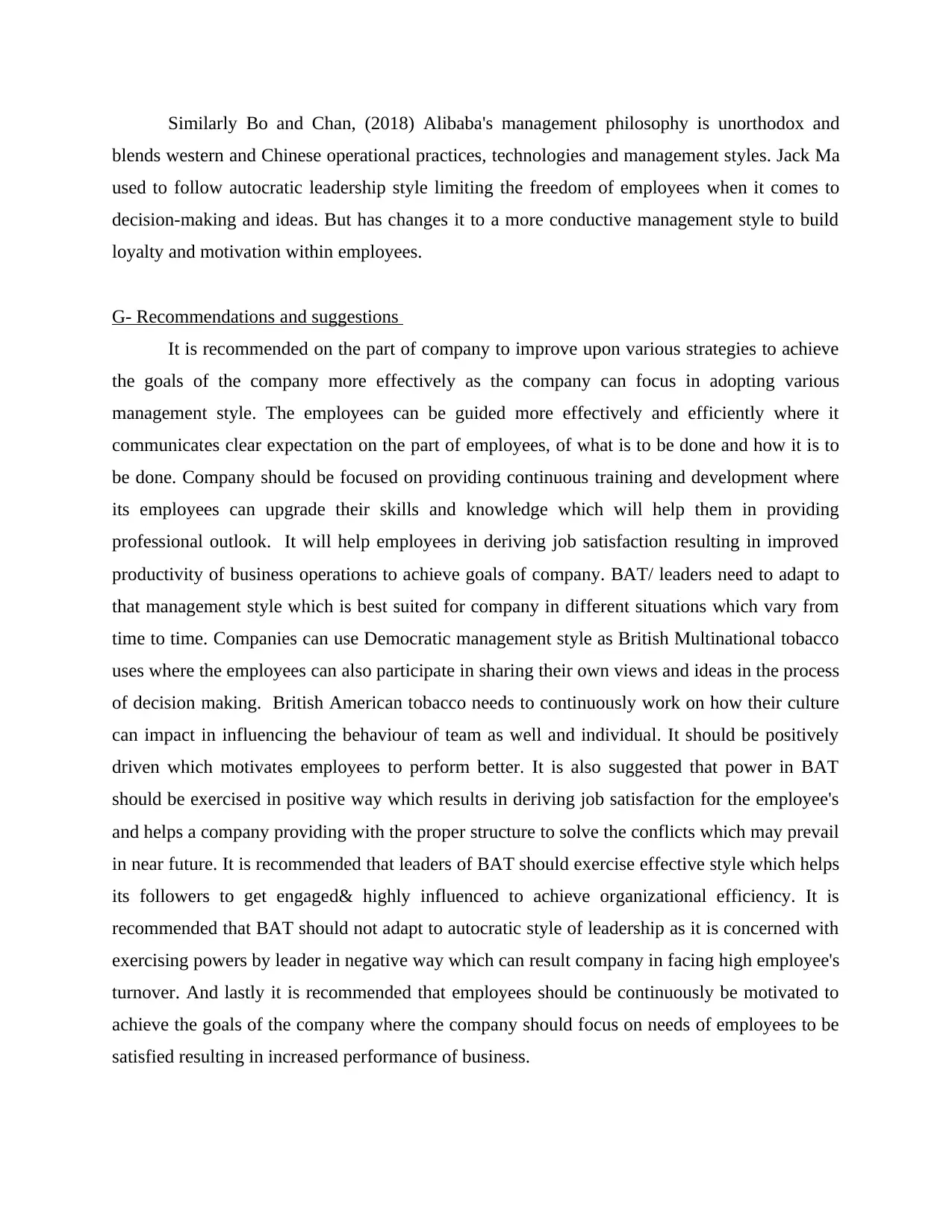
Similarly Bo and Chan, (2018) Alibaba's management philosophy is unorthodox and
blends western and Chinese operational practices, technologies and management styles. Jack Ma
used to follow autocratic leadership style limiting the freedom of employees when it comes to
decision-making and ideas. But has changes it to a more conductive management style to build
loyalty and motivation within employees.
G- Recommendations and suggestions
It is recommended on the part of company to improve upon various strategies to achieve
the goals of the company more effectively as the company can focus in adopting various
management style. The employees can be guided more effectively and efficiently where it
communicates clear expectation on the part of employees, of what is to be done and how it is to
be done. Company should be focused on providing continuous training and development where
its employees can upgrade their skills and knowledge which will help them in providing
professional outlook. It will help employees in deriving job satisfaction resulting in improved
productivity of business operations to achieve goals of company. BAT/ leaders need to adapt to
that management style which is best suited for company in different situations which vary from
time to time. Companies can use Democratic management style as British Multinational tobacco
uses where the employees can also participate in sharing their own views and ideas in the process
of decision making. British American tobacco needs to continuously work on how their culture
can impact in influencing the behaviour of team as well and individual. It should be positively
driven which motivates employees to perform better. It is also suggested that power in BAT
should be exercised in positive way which results in deriving job satisfaction for the employee's
and helps a company providing with the proper structure to solve the conflicts which may prevail
in near future. It is recommended that leaders of BAT should exercise effective style which helps
its followers to get engaged& highly influenced to achieve organizational efficiency. It is
recommended that BAT should not adapt to autocratic style of leadership as it is concerned with
exercising powers by leader in negative way which can result company in facing high employee's
turnover. And lastly it is recommended that employees should be continuously be motivated to
achieve the goals of the company where the company should focus on needs of employees to be
satisfied resulting in increased performance of business.
blends western and Chinese operational practices, technologies and management styles. Jack Ma
used to follow autocratic leadership style limiting the freedom of employees when it comes to
decision-making and ideas. But has changes it to a more conductive management style to build
loyalty and motivation within employees.
G- Recommendations and suggestions
It is recommended on the part of company to improve upon various strategies to achieve
the goals of the company more effectively as the company can focus in adopting various
management style. The employees can be guided more effectively and efficiently where it
communicates clear expectation on the part of employees, of what is to be done and how it is to
be done. Company should be focused on providing continuous training and development where
its employees can upgrade their skills and knowledge which will help them in providing
professional outlook. It will help employees in deriving job satisfaction resulting in improved
productivity of business operations to achieve goals of company. BAT/ leaders need to adapt to
that management style which is best suited for company in different situations which vary from
time to time. Companies can use Democratic management style as British Multinational tobacco
uses where the employees can also participate in sharing their own views and ideas in the process
of decision making. British American tobacco needs to continuously work on how their culture
can impact in influencing the behaviour of team as well and individual. It should be positively
driven which motivates employees to perform better. It is also suggested that power in BAT
should be exercised in positive way which results in deriving job satisfaction for the employee's
and helps a company providing with the proper structure to solve the conflicts which may prevail
in near future. It is recommended that leaders of BAT should exercise effective style which helps
its followers to get engaged& highly influenced to achieve organizational efficiency. It is
recommended that BAT should not adapt to autocratic style of leadership as it is concerned with
exercising powers by leader in negative way which can result company in facing high employee's
turnover. And lastly it is recommended that employees should be continuously be motivated to
achieve the goals of the company where the company should focus on needs of employees to be
satisfied resulting in increased performance of business.
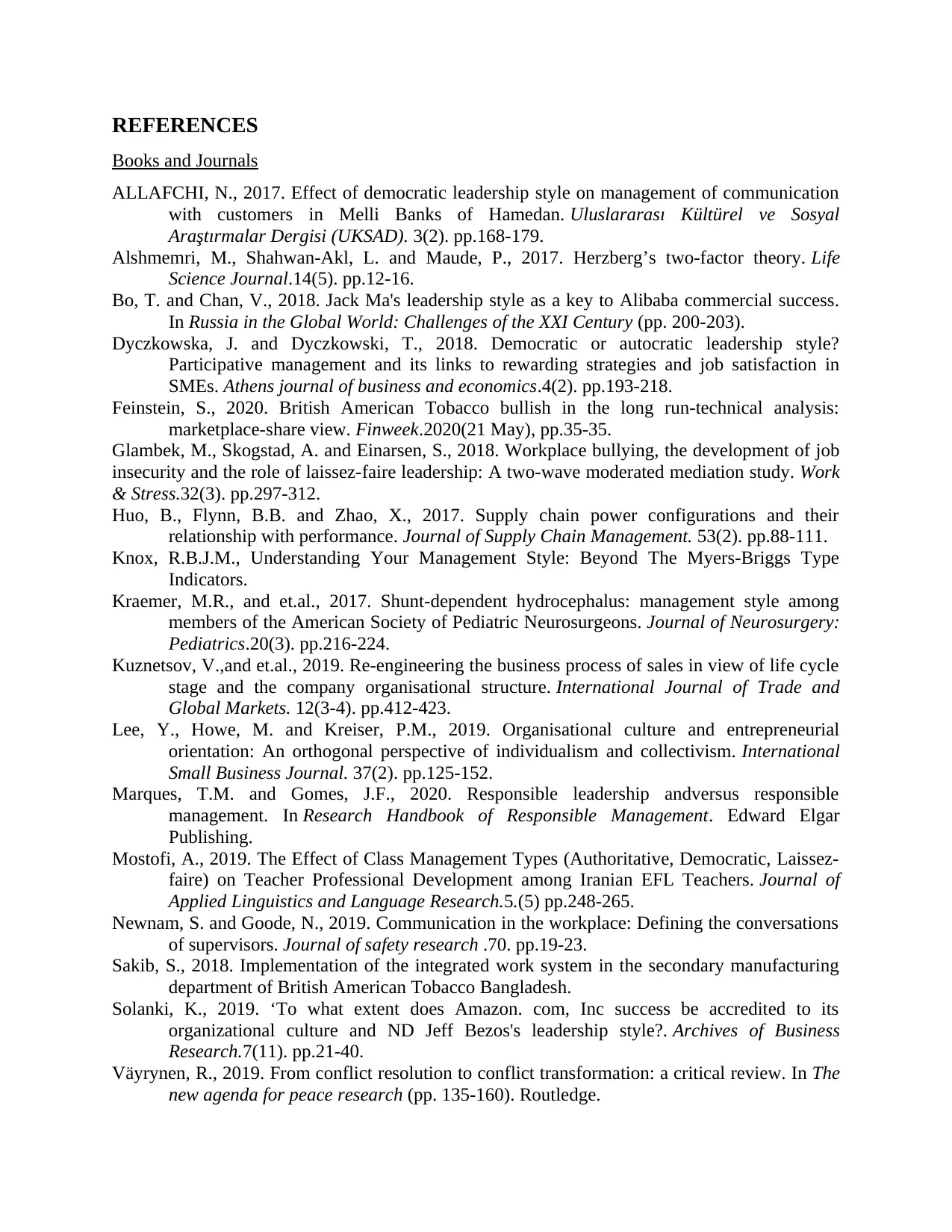
REFERENCES
Books and Journals
ALLAFCHI, N., 2017. Effect of democratic leadership style on management of communication
with customers in Melli Banks of Hamedan. Uluslararası Kültürel ve Sosyal
Araştırmalar Dergisi (UKSAD). 3(2). pp.168-179.
Alshmemri, M., Shahwan-Akl, L. and Maude, P., 2017. Herzberg’s two-factor theory. Life
Science Journal.14(5). pp.12-16.
Bo, T. and Chan, V., 2018. Jack Ma's leadership style as a key to Alibaba commercial success.
In Russia in the Global World: Challenges of the XXI Century (pp. 200-203).
Dyczkowska, J. and Dyczkowski, T., 2018. Democratic or autocratic leadership style?
Participative management and its links to rewarding strategies and job satisfaction in
SMEs. Athens journal of business and economics.4(2). pp.193-218.
Feinstein, S., 2020. British American Tobacco bullish in the long run-technical analysis:
marketplace-share view. Finweek.2020(21 May), pp.35-35.
Glambek, M., Skogstad, A. and Einarsen, S., 2018. Workplace bullying, the development of job
insecurity and the role of laissez-faire leadership: A two-wave moderated mediation study. Work
& Stress.32(3). pp.297-312.
Huo, B., Flynn, B.B. and Zhao, X., 2017. Supply chain power configurations and their
relationship with performance. Journal of Supply Chain Management. 53(2). pp.88-111.
Knox, R.B.J.M., Understanding Your Management Style: Beyond The Myers-Briggs Type
Indicators.
Kraemer, M.R., and et.al., 2017. Shunt-dependent hydrocephalus: management style among
members of the American Society of Pediatric Neurosurgeons. Journal of Neurosurgery:
Pediatrics.20(3). pp.216-224.
Kuznetsov, V.,and et.al., 2019. Re-engineering the business process of sales in view of life cycle
stage and the company organisational structure. International Journal of Trade and
Global Markets. 12(3-4). pp.412-423.
Lee, Y., Howe, M. and Kreiser, P.M., 2019. Organisational culture and entrepreneurial
orientation: An orthogonal perspective of individualism and collectivism. International
Small Business Journal. 37(2). pp.125-152.
Marques, T.M. and Gomes, J.F., 2020. Responsible leadership andversus responsible
management. In Research Handbook of Responsible Management. Edward Elgar
Publishing.
Mostofi, A., 2019. The Effect of Class Management Types (Authoritative, Democratic, Laissez-
faire) on Teacher Professional Development among Iranian EFL Teachers. Journal of
Applied Linguistics and Language Research.5.(5) pp.248-265.
Newnam, S. and Goode, N., 2019. Communication in the workplace: Defining the conversations
of supervisors. Journal of safety research .70. pp.19-23.
Sakib, S., 2018. Implementation of the integrated work system in the secondary manufacturing
department of British American Tobacco Bangladesh.
Solanki, K., 2019. ‘To what extent does Amazon. com, Inc success be accredited to its
organizational culture and ND Jeff Bezos's leadership style?. Archives of Business
Research.7(11). pp.21-40.
Väyrynen, R., 2019. From conflict resolution to conflict transformation: a critical review. In The
new agenda for peace research (pp. 135-160). Routledge.
Books and Journals
ALLAFCHI, N., 2017. Effect of democratic leadership style on management of communication
with customers in Melli Banks of Hamedan. Uluslararası Kültürel ve Sosyal
Araştırmalar Dergisi (UKSAD). 3(2). pp.168-179.
Alshmemri, M., Shahwan-Akl, L. and Maude, P., 2017. Herzberg’s two-factor theory. Life
Science Journal.14(5). pp.12-16.
Bo, T. and Chan, V., 2018. Jack Ma's leadership style as a key to Alibaba commercial success.
In Russia in the Global World: Challenges of the XXI Century (pp. 200-203).
Dyczkowska, J. and Dyczkowski, T., 2018. Democratic or autocratic leadership style?
Participative management and its links to rewarding strategies and job satisfaction in
SMEs. Athens journal of business and economics.4(2). pp.193-218.
Feinstein, S., 2020. British American Tobacco bullish in the long run-technical analysis:
marketplace-share view. Finweek.2020(21 May), pp.35-35.
Glambek, M., Skogstad, A. and Einarsen, S., 2018. Workplace bullying, the development of job
insecurity and the role of laissez-faire leadership: A two-wave moderated mediation study. Work
& Stress.32(3). pp.297-312.
Huo, B., Flynn, B.B. and Zhao, X., 2017. Supply chain power configurations and their
relationship with performance. Journal of Supply Chain Management. 53(2). pp.88-111.
Knox, R.B.J.M., Understanding Your Management Style: Beyond The Myers-Briggs Type
Indicators.
Kraemer, M.R., and et.al., 2017. Shunt-dependent hydrocephalus: management style among
members of the American Society of Pediatric Neurosurgeons. Journal of Neurosurgery:
Pediatrics.20(3). pp.216-224.
Kuznetsov, V.,and et.al., 2019. Re-engineering the business process of sales in view of life cycle
stage and the company organisational structure. International Journal of Trade and
Global Markets. 12(3-4). pp.412-423.
Lee, Y., Howe, M. and Kreiser, P.M., 2019. Organisational culture and entrepreneurial
orientation: An orthogonal perspective of individualism and collectivism. International
Small Business Journal. 37(2). pp.125-152.
Marques, T.M. and Gomes, J.F., 2020. Responsible leadership andversus responsible
management. In Research Handbook of Responsible Management. Edward Elgar
Publishing.
Mostofi, A., 2019. The Effect of Class Management Types (Authoritative, Democratic, Laissez-
faire) on Teacher Professional Development among Iranian EFL Teachers. Journal of
Applied Linguistics and Language Research.5.(5) pp.248-265.
Newnam, S. and Goode, N., 2019. Communication in the workplace: Defining the conversations
of supervisors. Journal of safety research .70. pp.19-23.
Sakib, S., 2018. Implementation of the integrated work system in the secondary manufacturing
department of British American Tobacco Bangladesh.
Solanki, K., 2019. ‘To what extent does Amazon. com, Inc success be accredited to its
organizational culture and ND Jeff Bezos's leadership style?. Archives of Business
Research.7(11). pp.21-40.
Väyrynen, R., 2019. From conflict resolution to conflict transformation: a critical review. In The
new agenda for peace research (pp. 135-160). Routledge.
Paraphrase This Document
Need a fresh take? Get an instant paraphrase of this document with our AI Paraphraser
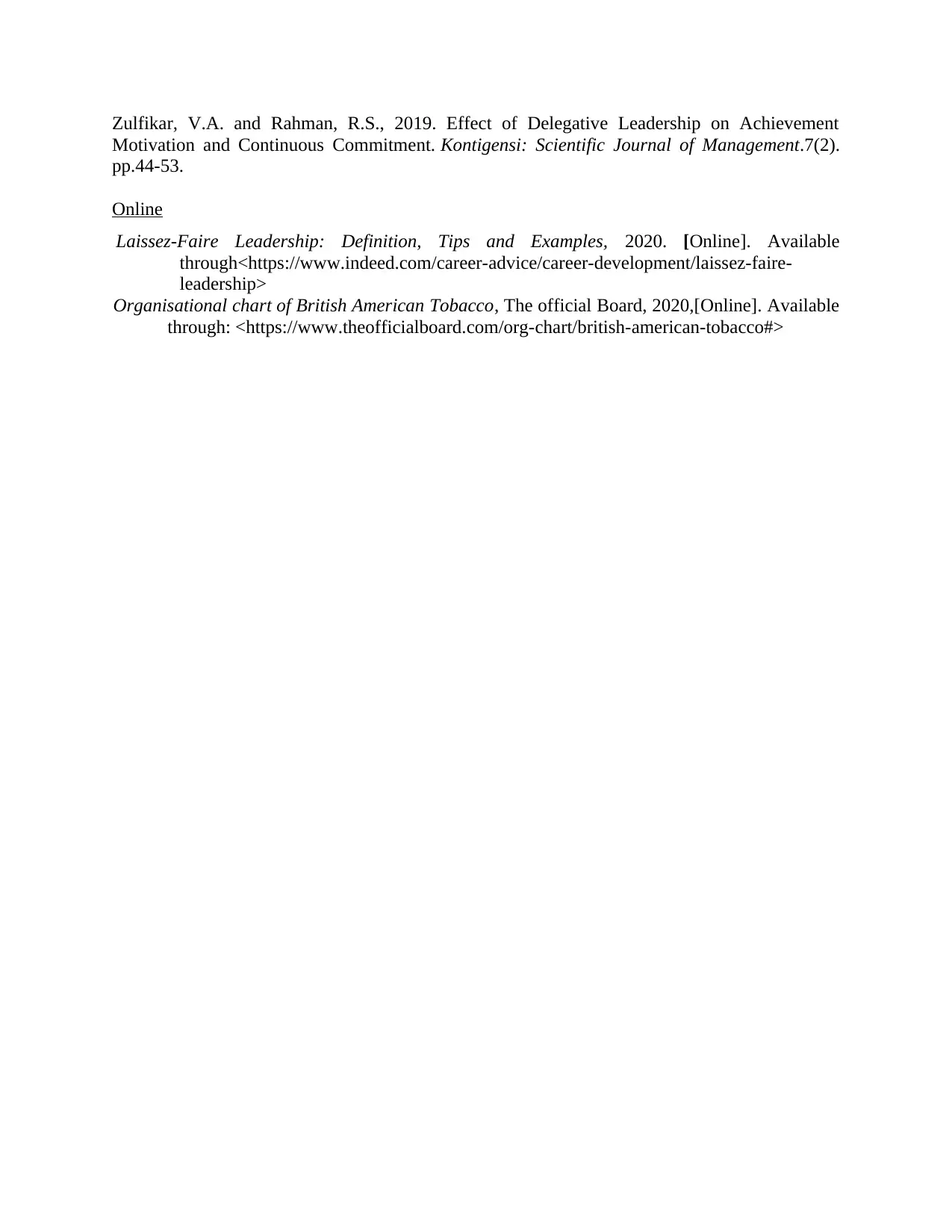
Zulfikar, V.A. and Rahman, R.S., 2019. Effect of Delegative Leadership on Achievement
Motivation and Continuous Commitment. Kontigensi: Scientific Journal of Management.7(2).
pp.44-53.
Online
Laissez-Faire Leadership: Definition, Tips and Examples, 2020. [Online]. Available
through<https://www.indeed.com/career-advice/career-development/laissez-faire-
leadership>
Organisational chart of British American Tobacco, The official Board, 2020,[Online]. Available
through: <https://www.theofficialboard.com/org-chart/british-american-tobacco#>
Motivation and Continuous Commitment. Kontigensi: Scientific Journal of Management.7(2).
pp.44-53.
Online
Laissez-Faire Leadership: Definition, Tips and Examples, 2020. [Online]. Available
through<https://www.indeed.com/career-advice/career-development/laissez-faire-
leadership>
Organisational chart of British American Tobacco, The official Board, 2020,[Online]. Available
through: <https://www.theofficialboard.com/org-chart/british-american-tobacco#>
1 out of 14
Related Documents
Your All-in-One AI-Powered Toolkit for Academic Success.
+13062052269
info@desklib.com
Available 24*7 on WhatsApp / Email
![[object Object]](/_next/static/media/star-bottom.7253800d.svg)
Unlock your academic potential
© 2024 | Zucol Services PVT LTD | All rights reserved.





